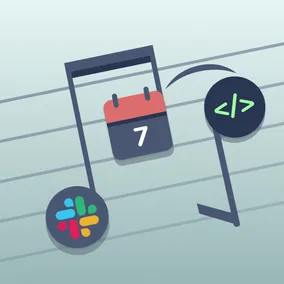How to Find Your Rhythm in a New Job

Diamond Alexander, Former Front-End Developer Apprentice
Article Categories:
Posted on
How do you get into the groove when you're in a new position or organization? Set a rhythm and then improvise!
When I think about rhythm, my mind immediately goes to jazz music. I played the vibraphone in my high school’s jazz band and quickly fell in love with it. Jazz is a beautiful combination of a rhythmic foundation paired with dazzling improvisation.
As a Viget apprentice this fall, I think that finding my rhythm here has taken that same form. I’ve had to create a base schedule for accomplishing my tasks each day (the rhythmic foundation) while embracing the flexibility and flow of ever-changing projects (the improvisation). Reflecting on my time at Viget so far, here are my three tips for finding your groove in a new role - plus, a jazz playlist that's perfect for work at the end!
Catch the Beat
In jazz, there is always a baseline rhythm and beat that provide the foundation solo musicians need before adding their improvised melodies. Just like a musician in a jazz band, finding your rhythm at a new job before adding your unique flair is crucial.
When just starting, I found myself wanting to be exposed to everything at Viget all at once. I eventually found that by taking my time to absorb one topic or company value at a time and letting that one thing be my guiding focus, I felt more grounded and prepared to move on to the next thing.
Pro Tip: Amy Townsend, a Front-End Developer at Viget and former intern, suggests setting daily goals as a way to ground yourself and your work. When setting goals, she advises incorporating both job-related goals as well as personal ones, always checking that you’re moving in the direction you most want to go down.
Improvise
Improvisation is the creation of a new melody or solo that complements the rhythmic foundation of a tune, and it's a defining characteristic of jazz music. Improvised pieces are usually unique to the musician and aren't played the same way twice.
Just like a jazz musician, once I felt more comfortable and grounded in my day-to-day work, I was ready to add in new notes and melodies. I started by scheduling 1:1s throughout the week to meet people from different disciplines. Then, I volunteered to get more involved at Viget (like writing this article!) or help out where I saw a need. These are just a couple of the ways I added punctuation to the foundational rhythm I established early on.
Pro tip: Lauren Butler, a UX Designer Apprentice, is all for improvisation. During her apprenticeship, she’s found her best opportunities for collaboration and learning come from being open to what shows up each day. "I try to stay open-minded and ready to jump into anything, anytime,” she adds, having recently contributed user flows to a client’s ticketing redesign project.
Feel the Groove
As a musician improvises, they remain aware of the "key" and timing of the tune being played. Improvisation isn’t something you can fully plan out - it’s something you have to feel into and adjust as you play the line.
When asking around for advice on finding one’s rhythm at work, Peyton Chance, a Project Manager at Viget and former intern, had this to offer: “Something that worked for a few months may not work a few months later.” Being flexible and “feeling the groove” means you choose to remain open to how you work best and not feeling stuck with that decision forever.
Pro tip: Peyton’s other piece of advice - if something isn’t working, fix it. When I was struggling to find my rhythm, I took this advice to heart and moved desks to an area of the office with less foot traffic and more natural light. That one change made a huge impact on my productivity.
Recap
Getting into the groove in a new role or at a new company can take time but having a plan can help make the process of going from "just trying to catch the beat" to "full-on improvisation" easier. In case you're short on time, here's a quick recap of the ways you can find your rhythm in a new position, plus a few extra ones:
- Spend time in the kitchen or common areas of your job. Doing this is what Becky Radnaev, a Viget UX Designer, calls “intentional serendipity” for meeting people
- Confidently schedule 1:1s with people from different departments and disciplines (#CalendarCreep)
- Join the big Slack channels at your company but also have fun digging into the more obscure and niche ones to get to know others with similar interests
- Raise your hand to get involved, anything from giving a presentation to helping set up at your company lunch
- As you find your rhythm, it’s okay to say no to some things so you can focus on other things you truly want to pursue
- Refer back to your goals a couple of times a week to keep on track
- Listen to your gut, making improvisational adjustments as you need to
And...a piece on jazz and work rhythms wouldn’t be complete without an accompanying playlist! Here are a few of my favorite jazz standards, perfect for an afternoon focus session.
What’s your #1 tip for finding your rhythm at work - share below! And if you’re into jazz, any jazz classics I should add to the playlist?